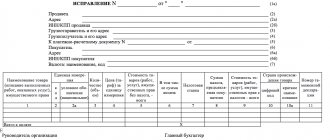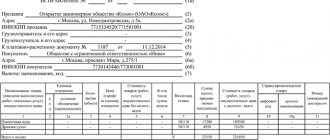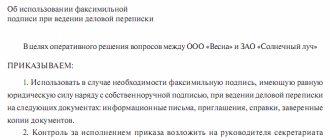What is it needed for?
A document on the basis of which the buyer of goods will be able to withhold VAT. When a retailer receives advance payment for its own goods, what should it do with it? She must issue an invoice to the consumer company. It makes no sense whether the seller shipped the goods or not. This will be considered an advance invoice.
If for any reason the seller returns the advance payment or after shipment there is a balance of the advance payment, then in both cases the buyer does not need to issue an invoice.
The peculiarities of filling out the document are associated with the fact that it will need to reflect the circumstance of receiving an advance payment. For this purpose, on the basis of which the advance was paid are recorded in the invoice
Read more about why an advance invoice is needed here.
Deadlines
In accordance with paragraph 3 of Art. 168 of the Tax Code of the Russian Federation, if the seller has received payment for the future delivery of goods (performance of work, provision of services), he is obliged to draw up an invoice within 5 days from the date of receipt. VAT should be charged on the prepayment received and paid to the budget - this is why an advance invoice is needed, but it is not always drawn up.
They do not calculate VAT and do not issue a document in the cases listed in paragraph 1 of Art. 154 of the Tax Code of the Russian Federation, when advance payment is received for goods (work, services):
- which are taxed at a rate of 0% (clause 1 of Article 164 of the Tax Code of the Russian Federation);
- which are not taxed in accordance with Art. 149, paragraph 2 of Art. 146 Tax Code of the Russian Federation;
- the place of sale of which is not recognized by the Russian Federation (Article 147, Article 148 of the Tax Code of the Russian Federation);
- with a long production cycle.
If the advance payment was made by a buyer who is not a VAT payer or is exempt from such obligations, the document is also not drawn up. This, in accordance with paragraphs. 1 clause 3 art. 169 of the Tax Code of the Russian Federation, must be agreed in writing with the buyer. If the parties have formalized such a procedure in writing, then the seller is obliged to register in the sales book payment slips or other documents on the repayment of advance payments by such a buyer for the calendar month.
Features
An advance invoice differs from an ordinary invoice in the reason for which it is issued, the period of formation and certain design elements. So it is set:
- upon receipt of funds from the consumer as a result of deliveries;
- regardless of the shipment of goods;
- without specifying individual details.
Please note that the amount of VAT must be included in it .
Reference! An advance invoice, as a rule, contains the same power as a shipping invoice, for this reason it should not be neglected.
If there was an error in the main invoice, you will need to issue a corrected invoice; if the terms of the transaction have changed, you will need to issue an adjustment invoice. As a rule, the corrected invoice has the same appearance as the original one. Even the immediate date and number in lines 1 of the original and corrected invoices are the same. And the difference between an invoice and a corrected one:
- the required details are indicated very correctly;
- line 1a is filled in, where the number and date of the correction are given.
Errors during checkout
Despite the rules and deadlines for issuing advance invoices established by the Tax Code, some taxpayers violate their obligations. The most common mistake an accountant makes is refusing to issue an advance payment document for each buyer's preliminary payment document.
Some entrepreneurs add the total amount to the received advance payment, subtract the shipment amount and, if an advance payment remains, draw up a document. As a rule, the procedure is performed every quarter.
Some people do not issue invoices if they received the product or service in full during the tax period (that is, there was a transfer of property rights in accordance with the contract).
Such methods of accounting are contrary to the law. If an inspector from the tax office comes, he will establish the presence of issued tax documents on advances. If the document is not completed, penalties will be charged for each day of delay.
In what cases is it required?
It is known that an invoice is issued for a specific advance payment . Many accountants issue an invoice for the prepayment made directly in the accounting program. However, it is printed only at the request of the consumer. They feel much calmer this way. Then they strictly comply with all the requirements of the Tax Code.
Read about in what cases and when an advance invoice is issued here.
If there is an agreement
At the time of receipt of goods directly subject to VAT at various rates (10% or 18%) on account of the completed shipment, the procedure for filling out column No. 1 of the invoice depends on the terms of the existing agreement. And if the data contained in the contract makes it possible to divide the volumes, as well as the cost of goods directly subject to VAT, they will need to be separated into separate items in the invoice.
If such a distribution is unrealistic, indicate in the invoice the direct name of the goods , and also the VAT rate of 18/118. At the time of issuing an invoice for prepayment (incomplete payment) under contracts that take into account various delivery times for goods, the funds for the advance payment (incomplete payment) are not required to be divided.
If there is no contract
An invoice must be issued for prepayment, even if an agreement with the consumer has not been concluded or if the agreement does not require the transfer of an advance payment. Whenever funds are received related to further supplies of goods, the seller is obliged to generate an invoice and present it to the buyer.
Otherwise, the seller may be held liable for taxation for severe non-compliance with the laws of accounting for profits and objects of taxation, which led to a direct understatement of the tax base. The direct buyer, if there is no provision in the contract for the direct transfer of the advance payment, the seller will need to prove in court his right to tax deduction of VAT from the advance invoice.
Invoice for the balance of the advance - at the end of the tax period?
| Can an organization, having shipped part of the goods on account of the received advance payment (five days after receiving the advance payment), issue an invoice for the remaining advance amount at the end of the tax period, if all operations were carried out in the same tax period? Experts from the Legal Consulting Service GARANT Nadezhda Vasilyeva and Olga Monaco answer. |
| Clause 1 of Article 167 of the Tax Code of the Russian Federation determines that the moment of determining the VAT tax base for the seller is the earliest of the following dates (unless otherwise provided by the Tax Code of the Russian Federation): — day of shipment (transfer) of goods (works, services), property rights; - the day of payment, partial payment for upcoming deliveries of goods (performance of work, provision of services), transfer of property rights. Consequently, upon receipt of an advance payment (advance), the taxpayer is obliged to calculate VAT on this amount and, on the basis of paragraph 3 of Article 168 of the Tax Code of the Russian Federation, no later than five calendar days from the date of receipt, draw up the corresponding invoice. The amount of tax in this case is calculated in the manner established by paragraph 4 of Article 164 of the Tax Code of the Russian Federation (clause 1 of Article 168 of the Tax Code of the Russian Federation). According to paragraph 14 of Article 167 of the Tax Code of the Russian Federation, if the moment of determining the tax base was the day of receipt of advance payment on account of upcoming deliveries of goods (performance of work, provision of services, transfer of property rights), then on the day of shipment of these goods (performance of work, provision of services, transfer of property rights) rights) against the previously received prepayment, the moment of determining the tax base also arises. Invoices issued and (or) issued upon receipt of payment (partial payment) for upcoming deliveries of goods (work, services) or transfer of property rights are registered by the taxpayer in the sales book in accordance with paragraphs 3 and 17 of the Rules for maintaining the sales book used in calculations for value added tax, approved. Decree of the Government of the Russian Federation dated December 26, 2011 No. 1137. Based on a literal reading of the norms of paragraph 14 of Article 167 of the Tax Code of the Russian Federation, there are no exceptions to the general rule for cases where prepayment and shipment take place in the same tax period. This opinion is shared by the tax authorities, explaining that upon receipt of payment (partial payment) for the upcoming delivery of goods (work, services), an invoice for the amount of such advance payment must be issued without fail, even if the shipment of goods (work, services) made no more than within five days after making advances (letters of the Federal Tax Service of Russia dated March 10, 2011 No. KE-4-3/3790, dated February 15, 2011 No. KE-3-3/354). However, according to the Ministry of Finance of Russia, if the shipment of goods (work, services) is carried out within five calendar days, counting from the day of receipt of the advance payment (partial payment), invoices for such advance payment are not required to be issued to customers (letters from the Ministry of Finance of Russia dated 12.10. 2011 No. 03-07-14/99, dated 03/06/2009 No. 03-07-15/39). When using these clarifications, it must be taken into account that such a conclusion does not follow from paragraph 3 of Article 168 of the Tax Code of the Russian Federation, but is based on the fact that upon shipment, the supplier will in any case issue an invoice, so issuing an advance invoice at the same time does not make sense , but only increases and complicates document flow. In addition, letters from the Ministry of Finance of Russia are advisory in nature, do not contain legal norms or general rules specifying regulatory requirements, and are not regulatory legal acts. The opinion of the judiciary on this issue is fundamentally different from the position of the regulatory authorities. Arbitration courts, in the case where prepayment and shipment occur in the same tax period, generally do not recognize such payments as advance payments for the purpose of calculating VAT, while they rely on the position of the Supreme Arbitration Court of the Russian Federation, which is that an advance payment cannot be recognized , received by the taxpayer in the same tax period in which the shipment took place (Resolutions of the Presidium of the Supreme Arbitration Court of the Russian Federation dated March 10, 2009 No. 10022/08, dated February 27, 2006 No. 10927/05, resolutions of the Federal Antimonopoly Service of the Volga District dated December 22, 2008 No. A55-3598/08 , FAS Moscow District dated January 23, 2013 No. F05-15410/12, dated April 23, 2010 No. KA-A40/3908-10, dated July 17, 2008 No. KA-A41/5427-08, FAS Far Eastern District dated November 28, 2008 No. F03 -4597/2008). If you follow this position, the seller must issue invoices for the received advance payment only if the shipment of the goods for which it was received will take place in the next tax period. Thus, in our opinion, the above position of the Federal Tax Service of Russia is the most consistent with the norms of Chapter 21 of the Tax Code of the Russian Federation, which do not make the obligation of taxpayers to charge VAT and issue invoices upon receipt of an advance payment dependent on the period (terms) of subsequent shipment of goods (works, services) ). If an organization adopts a different procedure for issuing invoices for advances received, different from that recommended by the Federal Tax Service of Russia, namely, it issues an invoice for the remaining amount of the advance at the end of the tax period, then with a high probability this approach may cause a tax dispute. And in this case, there is a high probability that the organization will have to defend its position in court. The texts of the documents mentioned in the experts’ response can be found in the GARANT legal reference system. |
Decor
The invoice must be issued on a special form , which is confirmed by Decree of the Government of the Russian Federation dated December 26, 2011 No. 1137. The invoice must include:
- number, date of the document (in the case of using the 1C program, the prefix A is added to the number);
- imprint of your company;
- output information of your counterparty;
- information about the act under which the advance was transferred.
If on 1 day there were a number of transfers from the 1st buyer, then the following will need to be entered in the invoice:
- all payments;
- payment currency, its code;
- required payment amount;
- name of the product for which the advance is transferred (from the existing contract);
- the amount of VAT on a particular product in the format 18/118, 10/110;
- direct VAT amount.
Advance invoice - requirements for completion, sample
It is possible that an advance may be received in non-monetary form; in this case, this field is not filled in. 6,6a,6b Buyer details - fields are filled in by analogy with 2, 2a and 2b. 7 Name of currency and OKV code. For the Russian ruble, the code corresponds to 643. Data on the currency in which the received money is expressed is indicated. For example, if the price is expressed in the currency of another state, but payment was received in Russian rubles, then the currency with code 643 is entered in this field. Filling out the columns of table 1 In this column you can indicate the name of each product if this information is known (for example, determined by the supply agreement ). If at the time of issuing the s/f in connection with the receipt of advance money the specific assortment is not known, you can indicate a general name (for example, “furniture” or “household goods”). 2-6 Dashes are added, these columns will be filled in at the time of issuing the s/f upon shipment against the advance received 7 The VAT rate is indicated in the format “18/118” or “10/110”, since upon receipt of an advance tax is allocated from amount, and not its accrual, as is done during shipment. 8 The amount of calculated tax, equal to the result of multiplying the rate from column 7 by the amount of the advance received. 9 The amount of the advance amount received. 10-11 Dashes are added.
Please note => During what period did the payment calculation system in the Pension Fund change?
Features of prepayment recording
- When issuing invoices, either the name itself or the general name of a group of goods is written in the column “name of the product...”, without requiring advance payment, contracts, or invoices.
- In column No. 1, the name of the goods must correspond to the name confirmed in the agreement for the supply of goods. If such a name is general (for example, petroleum products, confectionery products). In addition to the name of the goods, the invoice must indicate the details of the agreement for the fulfillment of which an advance (partial payment) was received.
- The “prepayment” entry in the advance invoice is created automatically.
If there is no data for advance invoices, then proceed differently . Individual entrepreneurs often have conditions that do not fall under a single procedure. Let us analyze special cases associated with the registration of a business transaction.
This will make it possible to understand how to deal with the account directly in the purchase book. To record actions and control them, these documents are recorded in a special journal specialized for account registration.
Amount in advance invoice
Good afternoon, There are two official points of view on this issue: the Federal Tax Service of the Russian Federation and the Ministry of Finance of the Russian Federation. 1. Letters of the Federal Tax Service of the Russian Federation dated March 10, 2011 N KE-4-3/3790, dated February 15, 2011 N KE-3-3/354 say: Thus, regardless of the fact that within five calendar days after receipt by the taxpayer value added tax prepayment for the upcoming supply of goods (work, services) falling within the same tax period or for different tax periods, the goods (work, services) are shipped, invoices are issued in two copies both for the amount of the prepayment received and when shipping goods (works, services) against the specified prepayment.
Therefore, according to the first point of view (Federal Tax Service of the Russian Federation), if an organization receives an advance payment, then it is obliged to issue an invoice for the advance payment, even if the entire sales transaction occurs within one quarter or within five calendar days.
2. In Letters of the Ministry of Finance of the Russian Federation dated November 10, 2016 N 03-07-14/65759, dated March 6, 2009 N 03-07-15/39, it is said: If within five calendar days, counting from the date of receipt of the advance payment ( partial payment), goods are shipped (performance of work, provision of services, transfer of property rights) on account of this payment (partial payment), then invoices for advance payment (partial payment) should not be issued to the buyer.
Therefore, according to the second point of view (MoF of the Russian Federation), it is not necessary to issue an advance invoice in a situation in which the shipment occurred within 5 calendar days from the date of receipt of the advance on account of this shipment.
Based on the above official positions, issuing invoices only for the amounts of advances remaining at the end of the quarter is not provided for by the Tax Code of the Russian Federation. In this situation, in accordance with the provisions of Art. 168 of the Tax Code of the Russian Federation, in the event that the supplier receives an advance payment for upcoming deliveries of goods (performance of work, provision of services), the supplier must draw up an advance invoice for the entire amount of the advance received. An invoice for the amount of the advance received is drawn up in two copies, one of which is transferred to the buyer (clause 6 of the Rules for filling out an invoice, approved by Decree of the Government of the Russian Federation of December 26, 2011 N 1137). The specified advance invoice is registered in the sales ledger according to the date of preparation of the advance invoice.
At the time of shipment of goods (performance of work, provision of services) on account of a previously received advance (partial payment), the supplier can submit the amount of VAT from the advance for deduction (clause 8 of Article 171 of the Tax Code of the Russian Federation, clause 6 of Article 172 of the Tax Code of the Russian Federation) Letter Federal Tax Service of the Russian Federation dated March 10, 2011 N KE-4-3/3790
If the advance payment is not fully processed (the cost of shipped goods, works, services is less than the amount of the advance payment received), only the part of the VAT accrued on the advance payment corresponding to the amount of the shipment can be deducted. When shipping goods (works, services) on account of a previously received advance, the supplier issues an invoice and registers it in the sales book. At the same time, he registers the invoice issued upon receipt of the advance in the purchase book. According to paragraph 6 of Art. 172 of the Tax Code of the Russian Federation - deductions of tax amounts are made from the date of shipment of goods (performance of work, provision of services), in the amount of tax calculated from the cost of shipped goods (performed work, rendered services), in payment of which the amounts of previously received payment, partial payment are subject to offset .
Sincerely, A. Greshkina
Rules for filling out the document: step-by-step instructions
First, let's fill in the rows , they are located in front of the tabular part:
- Line No. 1 – serial number (taken from the list of documents), date.
- Line 2, 2a, 2b – location and details of the seller.
- Line 4 – write the location of the final recipient, if the final addressee is also a consumer of the product, then put a dash.
- Line 5 – here we write the number and date of the document. When issuing an invoice based on several payments at once, all payments without exception are indicated. If the advance payment for the goods was not made in cash, only then a dash is added in column 5. Thus, an invoice can be issued only upon receipt of payment.
- Line 6, 6a, 6b – location and details of the buyer.
- Line 7 is the code of the monetary unit, if it is the ruble, then 643.
- Line 8 – suppliers under a government contract show the code of such an agreement.
Now let's start filling out the tabular part of the form. In this part of the form, only sections 1, 7, 8 and 9 are filled out, and dashes are added in the others.
- Column 1 must indicate:
- Product Name;
presentation of work performed, services provided, property rights.
- Columns 2, 3, 4 (unit of measurement, number, price per piece of measurement) do not need to be filled out. In addition, the data in columns 10 and 11 (country of origin of the goods, customs declaration number) is not indicated. They need to have dashes. When calculating VAT specifically on the prepayment amount, the estimated tax amount is used.
- Section 7 – the estimated tax rate is indicated . It is possible to make a note in the act, say, accepted from such and such.
Will it be possible to write the phrase “Advance payment” instead of the product name? In another column, it is possible to write the phrase “Advance payment under the agreement...” without providing the name of the goods (works, services). Such wording in an “advance” invoice is quite possible. In such a case, in column 1 we advise you to write the phrase “Advance payment for... (name of product required) under the contract...”.
If the seller clearly understands for which goods (works, services) payment was received from the consumer, it is possible to indicate their direct names in column 1 of the invoice. In this case, it is necessary to make an integral note that the amount of tax is calculated directly from the amount of the purchased prepayment.
The completed form must be signed by the head of the company and its chief accountant , or in the absence of the latter, the responsible person.
You will find a detailed procedure for filling out the ASF here.
Recording an advance payment in accounting
The buyer, by virtue of Article 171 of the Tax Code of the Russian Federation (clause 12), accepts the existing advance VAT for deduction if:- there is a correctly approved invoice;
- there is an act certifying payment;
- The agreement stipulates the possibility of prepayment.
- Having transferred the advance payment, the buyer makes the following entries:
- Dt 60 Kt 51 - advance payment is transferred.
- Dt 68 Kt 76 - deposit VAT taken for deduction.
- Enters VAT withholding from advances in the purchase book with the invoice number directly issued by the seller.
- Reflects deposit VAT on line 130 of the VAT return.
- Then it restores advance VAT at the time of sale: Dt 76 Kt 68.
- Reflects VAT recovery directly in the sales book.
- Next, it reflects in the declaration VAT on advances on line 090 of section 3.
You can find out how to issue and register an invoice for an advance payment from a supplier in a separate article.
What it is
An invoice is a document that confirms the company's legal right to deductions prescribed by law. The paper establishes goods, works and services with VAT added to the price structure.
Article 168 of the Tax Code establishes that the seller must receive an invoice before receiving an advance payment for services or goods, or before actually fulfilling his obligations to the customer.
Article 171 of the Tax Code establishes that if an invoice is in hand, an organization has the right to apply for a tax deduction, as if it had already received a shipping document.
When considering Article 169 of the Tax Code of the Russian Federation, it is noticeable that invoices are in the same legal group, but are divided into 3 categories:
- a document that the customer issues when selling goods, providing services or performing work, or when transferring the rights of one subject to a transaction to another. Such invoices are informally called “Shipping”;
- a document that the supplier presents to the buyer at the time of receipt of a service, work or product. They are called advance and are the most common;
- adjustment documents that appeared in Russia in 2011. They are issued when the supplier reduces the quantity or price of an item to clarify current information.











